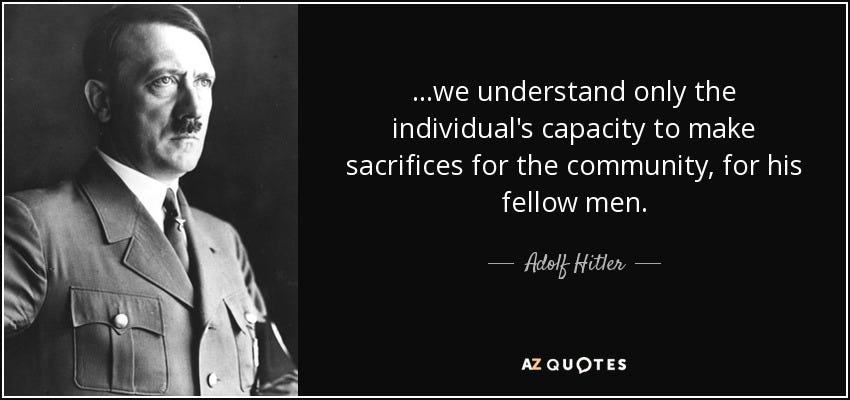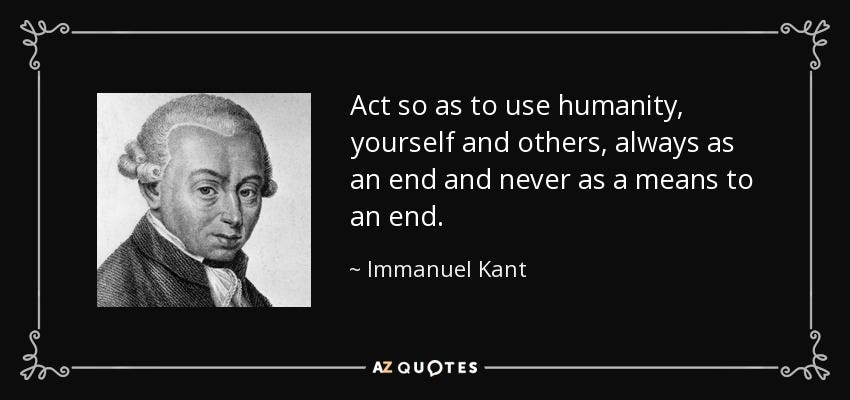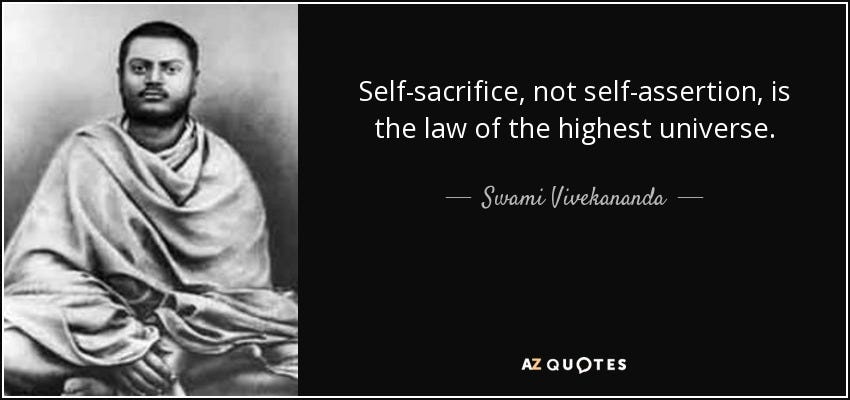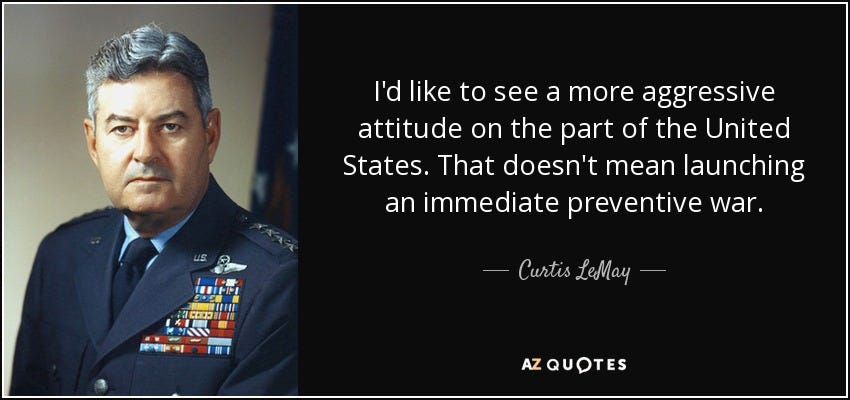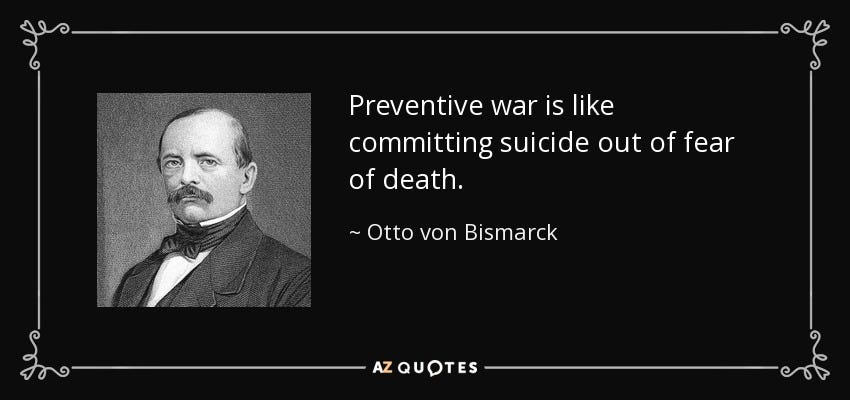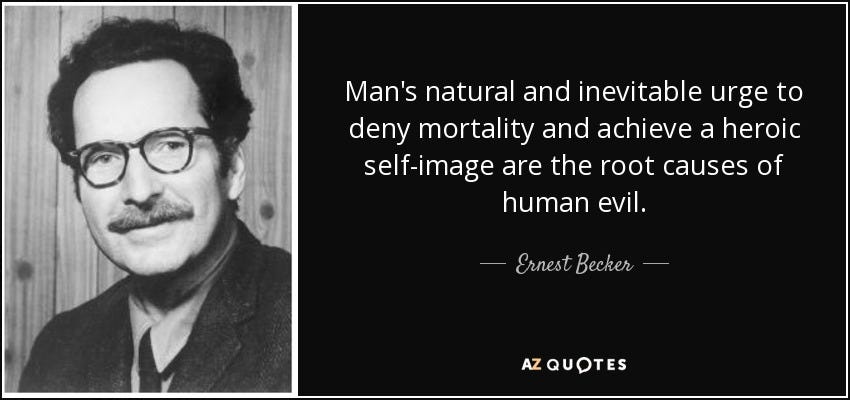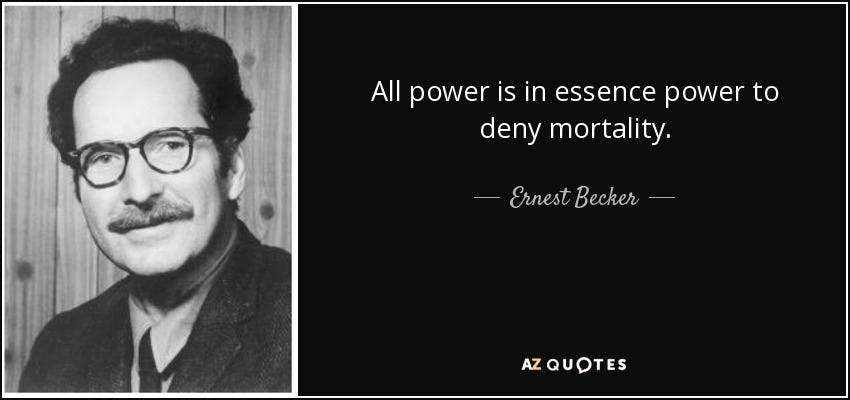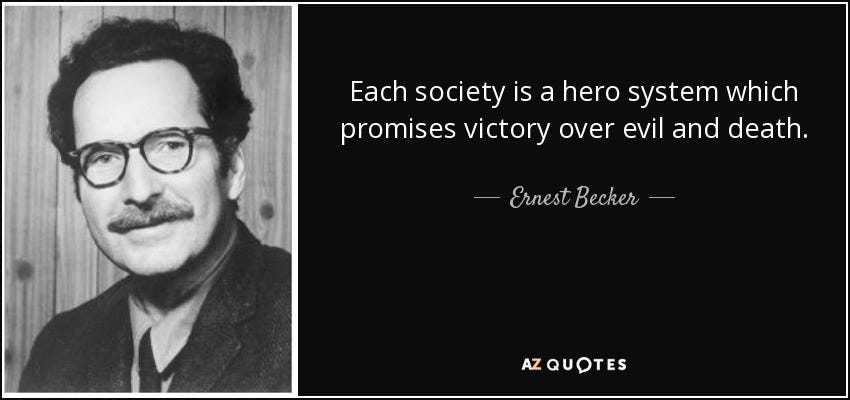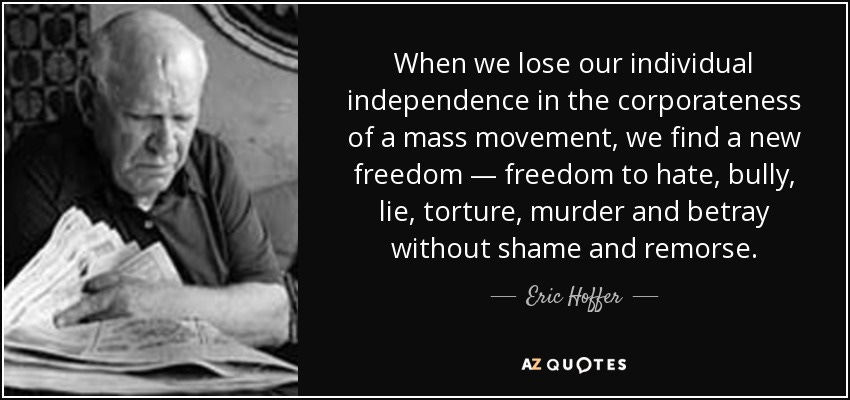Free Friends Forum 15--SELF-SACRIFICE: VIRTUE? OR VOLUNTARY SERVITUDE & ALTRUISTIC SUICIDE?
NOTHING GREATER THAN OUR SELVES
Here is the Substack post that generated FFF15: WHY SELF-SACRIFICE IS (STILL) THE MOST POWERFUL IDEA IN MOVIES Jon Miltimore, July 30, 2024 The idea of self-sacrifice as the height of human virtue is so widely accepted today that both religious and non-religious people easily identify with it.
AN INVITATION IN GOOD FAITH TO JON MILTIMORE AND ALL TO JOIN OUR DISCUSSION NORTH/SOUTH AMERICAS’ SATURDAY OR SUNDAY (see below for times).
I disagree with Jon about Self-Sacrifice (SS) being a virtue; on the contrary, I consider it an unnecessary, tragic waste of Humanity that should be understood and abandoned not praised and furthered.
LECTURE 12: THE EVIL OF SELF-SACRIFICE Nathaniel Branden Lecture Series, July 10, 2018. 1:17:22
JOIN US TO DISCUSS FFF15. SELF-SACRIFICE: VIRTUE? OR VOLUNTARY SERVITUDE & ALTRUISTIC SUICIDE?
FREE FRIENDS FORUM -- ABANDONED TO OURSELVES
An Open Forum for Naturalists, Humanists, and Individualists and their Opposites for Argument’s Sake
https://responsiblyfree.substack.com/p/free-friends-abandoned-to-ourselves
--Zoom Saturdays 9PM New Zealand time (for example, this will be Saturdays Australia 7-6PM; China 4PM; Thailand 3PM; Kenya 11AM; Nigeria/France/Spain/Germany 9AM)
--Zoom Sundays 9AM New Zealand time (for example, this will be Saturdays California 12noon; Florida 3PM; Chile 5pm; Nigeria/France/Spain/Germany 9PM)
--Zoom Mondays 9AM New Zealand time (for example, this will be Sundays California 12noon; Florida 3PM; Chile 5pm; Nigeria/France/Spain/Germany 9PM)
Personal World Clock tinyurl.com/bdef97z7
USE THE BELOW FOR EVERY MEETING
Jack Carney is inviting you to a scheduled Zoom meeting.
Join Zoom Meeting
https://us06web.zoom.us/j/8245320024
Meeting ID: 824 532 0024
Passcode: 772388
THE COMMON GOOD BEFORE THE GOOD OF THE INDIVIDUAL IS SLOGAN OF NEW SYSTEM. New York Times, May 1, 1934 https://www.nytimes.com/1934/05/01/archives/nazis-inaugurate-labor-code-today-the-common-good-before-the-good.html
HOW THE "GREATER GOOD" IS USED AS A TOOL OF SOCIAL CONTROL Academy of Ideas, Sept 23, 2020. 15:11
Transcript
How do politicians continue to convince the public to do away with their freedoms in favour of heavy-handed government control? Why are so few people defending liberty when a world absent of it is a world of mass suffering? It is often said that one cannot solve a problem if one is not even cognizant of it, and herein lies one of the reasons freedom is retreating so rapidly from our world. Many people still believe themselves to be free and as Goethe wrote: “None are more hopelessly enslaved than those who falsely believe they are free.”
This collectivist mindset is foundational to communism, fascism and socialism: “The common good before the individual good.” proclaimed one collectivism’s most infamous adherents. (Adolf Hitler) The doctrine of collectivism has been put into practice by many dictators such as Hitler, Lenin, Stalin, Pol Pot and Mao. Death, destruction and suffering on a mass scale was the end-result in each case.
https://academyofideas.com/2020/09/greater-good-tool-of-social-control/
SACRIFICE IS THE SACRED.
The etymology of sacrifice makes it clear:
SACRIFICE (N.)
"the offering of something (especially a life) to a deity as an act of propitiation, homage”; see sacred
https://www.etymonline.com/search?q=sacrifice
SACRED (ADJ.)
"hallowed, consecrated, or made holy by association with divinity or divine things or by religious ceremony or sanction," “to make sacred, consecrate; hold sacred; immortalize; set apart, dedicate,”
https://www.etymonline.com/word/sacred
SELF-SACRIFICE Wikipedia
“Self-sacrifice is the giving up of something that a person wants for themselves so that others can be helped or protected or so that other external values can be advanced or protected.” https://en.wikipedia.org/wiki/Self-sacrifice#External_links
AYN RAND LEXICON: SACRIFICE
“Sacrifice” is the surrender of a greater value for the sake of a lesser one or of a nonvalue. Thus, altruism gauges a man’s virtue by the degree to which he surrenders, renounces or betrays his values (since help to a stranger or an enemy is regarded as more virtuous, less “selfish,” than help to those one loves). The rational principle of conduct is the exact opposite: always act in accordance with the hierarchy of your values, and never sacrifice a greater value to a lesser one. Without such a hierarchy, neither rational conduct nor considered value judgments nor moral choices are possible. http://aynrandlexicon.com/lexicon/sacrifice.html
NATHANIEL BRANDEN ON SELF-SACRIFICE
The Objectivist ethics holds that man—every man—is an end in himself, not a means to the ends of others. He is not a sacrificial animal. As a living being, he must exist for his own sake, neither sacrificing himself to others nor sacrificing others to himself. The achievement of his own happiness is man's highest moral purpose.” P.237 “His life and self-esteem require of man loyalty to his values, loyalty to his mind and its judgments, loyalty to his life—but the essence of morality, men are taught, consists of self-sacrifice; the sacrifice of one's mind to some higher authority, and the sacrifice of one's values to whomever may claim to require it. It is not necessary, in this context, to analyze the almost countless evils entailed by the precept of self-sacrifice. But there are two aspects of the issue that are especially pertinent to the subject of mental health. The first is the fact that self-sacrifice means—and can only mean—mind-sacrifice. A sacrifice means the surrender of a higher value in favor of a lower value or of a nonvalue. If one gives up that which one does not value in order to obtain that which one does value—or if one gives up a lesser value in order to obtain a greater one—this is not a sacrifice, but a gain. The Psychology of Self-Esteem, p.242
ALTRUISTIC SUICIDE Wikipedia
Altruistic suicide is the sacrifice of one's life in order to save or benefit others, for the good of the group, or to preserve the traditions and honor of a society. It is always intentional. Benevolent suicide refers to the self-sacrifice of one's own life for the sake of the greater good.[1] Such a sacrifice may be performed for the sake of executing a particular action, or for the sake of keeping a natural balance in the society.
Altruistic suicide was seen by Émile Durkheim in his book Suicide: A Study In Sociology as the product of over-integration with society.[2][3] Real-life examples in his book include "a soldier choosing to go to war for his family/community/country". However, this type of categorization remained controversial, as it downplayed the valor of such actions.[4] According to Durkheim, altruistic suicide contrasts with egoistic suicide, fatalistic suicide, and anomic suicide.
https://en.wikipedia.org/wiki/Altruistic_suicide
ARE YOU SELF-SACRIFICING? Psychology Today. Aug 23, 2017, Lisa Tessman
Is what matters the most to you what really matters the most?
Sacrifices are typically called for when values conflict—two valuable things cannot both be had and one must be given up for the sake of the other. But not all sacrifices are self-sacrifices. For instance, the person who gives up something that benefits their self for some greater benefit to their own self—leaving the comfort of a spacious house in order to live in a small apartment closer to work—makes a sacrifice but not a self-sacrifice.
For something to count as a case of self-sacrifice:
· what is sacrificed must constitute, benefit, or matter to the self in some stronger sense than that for the sake of whom/which it is sacrificed; and,
· the sacrifice must be made for the sake of someone or something else.
https://www.psychologytoday.com/us/blog/im-only-human/201708/are-you-self-sacrificing
THE ART OF LETTING GO: HOW TO MAKE THE MOST OF SACRIFICE Psychology Today, Gregg Levoy, Aug 23, 2016
To sacrifice means to “to make sacred,” and it's about liberation, not defeat.
Sacrifice, to be sure, is a demand of the soul against the ego, passion against security—surrenders which may be liberation but often feel like defeat. But they're also a swapping of something temporal for something transcendent. In fact, the aim of sacrifice—true to its definition, “to make sacred”—is to forge a link with whatever’s greater than yourself, whether that’s God, community, nature, the future, the greater good, or even your own potential.
THE POSITIVE PSYCHOLOGY OF SELF-SACRIFICE International Network on Personal Meaning, Paul T. P. Wong, Dec 1, 2005
Is self-sacrifice the highest expression of virtue or the worst form of human folly? Who benefits from self-obliteration? How can one reconcile self-sacrifice with self-actualization? Millions have died fighting for the same ideals of freedom, democracy and equality. The cost of their self-sacrifice is immeasurable when we take into account the pain and grief of their surviving loved ones. Have they died in vain?
Let’s now consider in more detail the positive kind of self-sacrifice. When I prepared for a talk on Chinese positive psychology in Hong Kong, I could not help but think about the spirit of self-sacrifice prevalent in traditional Chinese families. Chinese positive psychology is collectivistic and paradoxical. The good life is defined by what is good for the family, for the group, rather than just for the self. It is through self-sacrifice for the larger good that one experiences true joy and fulfillment.
https://www.meaning.ca/article/the-positive-psychology-of-self-sacrifice/
THE NATURE OF GOODNESS by George Herbert Palmer, Chapter VI. Self-Sacrifice
Now what is distinctive of self-sacrifice is that it insists in a somewhat extreme way on this second and rational mode of regard. It is a frank confession of interlocking lives. It says, “I have nothing to do with the abstract, isolated, and finite self. That is a matter of no consequence. What I care about is the conjunct, social, and infinite self–that self which is inseparable from others. Where that calls, I serve.” The self-sacrificing person knows no interest of his own separate from those of his father and mother, his wife and children. He cannot ask what is good for himself and set it in contrast with what is good for them. For his own broader existence is presented in these dear members of his family. And such a man, so far from being mad, is wise as few of us are. Glorious indeed is the self- sacrificer, because he is so sane, because in him all pettiness and detachment are swept away. He appears mad only to those who stand at the opposite point of view, but in his eyes it is they who are ridiculous. In fact, each must be counted crazy or wise according to the view we take of what constitutes the real person.
https://www.authorama.com/nature-of-goodness-7.html
SELF SACRIFICE...THE MOST SELF CENTERED THING IN THE WORLD! Teal Swan, Feb 23, 2020. 20:57
Self Sacrifice is valued in our society. For example, Jesus sacrificed himself for the sins of the people... A mother sacrifices herself for her children. But is this Self Sacrifice or is it Self Centeredness? Teal takes us in depth into the motivation behind 'self sacrifice' and makes the case that self sacrifice actually doesn't exist.
ARTICLE
The only reason anyone does anything is because they think it will make them feel better if they do it. This is not bad. This does not mean that the entire universe is narcissistic. The truth of this universe is oneness. So the most enlightened being will be moved towards acts of altruism because they experience all things in the world as themselves. In a universe that is one, you could say that every act is self-centered because there is nothing that is not you. So, swallow the truth that there is nothing wrong with self-centered motives and that you can’t escape them even if you try and that the more enlightened you become, the more you experience that everything is you and so the more motivated you become to do things to increase the wellbeing of “others”.
SACRIFICE Wikipedia
Sacrifice is the offering of material possessions or the lives of animals or humans to a deity as an act of propitiation or worship.[1][2] Evidence of ritual animal sacrifice has been seen at least since ancient Hebrews and Greeks, and possibly existed before that. Evidence of ritual human sacrifice can also be found back to at least pre-Columbian civilizations of Mesoamerica as well as in European civilizations. Varieties of ritual non-human sacrifices are practiced by numerous religions today.
Sacrifice (particularly blood sacrifice) is an exclusively male rite almost worldwide[3] that serves to bond men: "it establishes a kinship which goes above and beyond the 'natural' bloodshed of childbirth."[4] Among other points, Korte draws a connection between sacrificial blood and fertility-related blood.[3]
https://en.wikipedia.org/wiki/Sacrifice
25 CULTURES THAT PRACTICED HUMAN SACRIFICE Facts Verse, Sept 22, 2019. 7:654
WHAT DROVE THE AZTECS TO PERFORM HUMAN SACRIFICES ON SUCH A LARGE SCALE?
THE PARADOX OF SACRIFICE
“All these sacrifices were intended to help the forces of life”
ON HUMAN SACRIFICE Nordic Animism, Sept 14, 2023. 16:15
10:51 Narrator> “This Danish Soldier here he was photographed in Afghanistan back in 2009 when a Danish documentary movie team had somehow managed to bypass the censorship of the official propaganda system and actually gotten into Afghanistan and made a documentary movie Armadillo about what was going on in there--and this is the moment where this young man has just realized that a grenade that he has just launched has torn to pieces the body of a nine-year-old girl. This is a human who went to war without having a deep realization of what violence is.”
ARMADILLO | OFFICIAL TRAILER | DocPlay. Oct 12, 2023. 1:40
HUMAN SACRIFICE IN PRE-COLUMBIAN CULTURES Wikipedia
The practice of human sacrifice in pre-Colombian cultures, in particular Mesoamerican and South American cultures, is well documented both in the archaeological records and in written sources. The exact ideologies behind child sacrifice in different pre-Colombian cultures are unknown but it is often thought to have been performed to placate certain gods.
https://en.wikipedia.org/wiki/Human_sacrifice_in_pre-Columbian_cultures
EVERY SACRIFICE RITUAL EXPLAINED IN 14 MINUTES The Analyst, June 4, 2024. 14:35
WHEN GOD DEMANDED HUMAN SACRIFICES | THE TRUTH ABOUT MOLOCH | Documentary MythVision Podcast, March 24, 2024. 45:28
Explore the dark history of child sacrifice in ancient Israel in our new documentary, inspired by Dr. Francesca Stavrakopoulou's research. This film uncovers the truth behind the terrifying rituals dedicated to deities like Moloch and Yahweh, challenging our perceptions of morality and the divine.
CHILD SACRIFICE Wikipedia
Child sacrifice is the ritualistic killing of children in order to please or appease a deity, supernatural beings, or sacred social order, tribal, group or national loyalties in order to achieve a desired result. As such, it is a form of human sacrifice. Child sacrifice is thought to be an extreme extension of the idea that the more important the object of sacrifice, the more devout the person rendering it.[1]
https://en.wikipedia.org/wiki/Child_sacrifice
CHILD ABUSE IN THE NEAR-SACRIFICE OF ISAAC Cindy Wang Brandt, March 20, 2018
https://cindywangbrandt.com/child-abuse-in-the-near-sacrifice-of-isaac/
WAR AS A SACRIFICIAL RITUAL: FROM FATALISM TO FATAL ERROR BY LLOYD DEMAUSE
https://prenatalsciences.org/portfolio/war-as-a-sacrificial-ritual/
THE ORIGINS OF WAR IN CHILD ABUSE BY LLOYD DEMAUSE
https://prenatalsciences.org/portfolio/the-origins-of-war-in-child-abuse/
WAR AS A SACRIFICIAL RITUAL BY LLOYD DEMAUSE
http://primal-page.com/mause.htm
A SUICIDAL EMBRACE: WAR AS SELF-PUNISHMENT AND SUICIDE
War is the collective desire to sacrifice and to punish each other. It is the result of the collective wish for self-punishment in a suicidal embrace of aggression and sacrifice. It is the hurt one inflicts on oneself during a period of enormous collective pain and/or guilt about perceived feelings.
The very acts of “sanctifying” war and the memories of war signal those who think clearly and carefully that they are being manipulated. Yet, since clear thinkers are usually in the minority, the state is able to accelerate the group’s desire for sacrifice and self-punishment by constantly plunging the group into repeated traumas and memories of trauma. These traumatic reminders actually create a trance state for the group where mental illness dominates – thus, leaders manipulate the collective sense of trance and encourage devotion and loyalty to the leader. Indeed, “loyalty” replaces logical thinking and the group plunges into the “illogical logic” of a collective trance. That’s what allows the group to perform this suicidal embrace of destruction.
https://psychohistory.com/articles/a-suicidal-embrace-war-as-self-punishment-and-suicide/
FIRST WORLD WAR AS SACRIFICIAL RITUAL by Richard A. Koenigsberg
War Office recruiting stands were inundated with men persuaded of their duty to fight. Soldiers were cheered on as they rushed off to battle.
Combatants joined the military and entered into battle— and civilians supported their willingness or desire to do so—because they believed it was their duty to fight to defend their nation. What occurred during the First World War grew out of the glorification of and attachment to “countries.” Monumental orgies of destruction were undertaken and justified in the name of entities or sacred-objects given
names like France, Germany, England, Russia, Italy, etc. What are “countries” and why do people get so excited about them? What is the relationship between our attachment to nations, on the one hand, and the willingness to kill, die and bear unendurable suffering on the other? John Lennon asked people to conceive of a world not defined or demarcated by nation-states: to envision human existence in the absence of countries. “Imagine there’s no country,” Lennon sang, “It isn’t hard
to do.” As it turns out, it is extremely difficult for people to imagine life
in the absence of countries. The First World War represented the acting out of an ideological proposition: “The individual must die so that the nation might live.”
https://www.libraryofsocialscience.com/assets/pdf/First_World_War_as_Sacrificial_Ritual.pdf
chrome-extension://blillmbchncajnhkjfdnincfndboieik/pdf/web/viewer.html?file=https://www.libraryofsocialscience.com/assets/pdf/First_World_War_as_Sacrificial_Ritual.pdf
“WAR FOLLOWS CHILD ABUSE AS NIGHT DAY” Foreign Policy In Focus, By Russ Wellen | August 30, 2011
Contrary to what international relations types may think, leaders seldom do a rigorous cost-benefit analysis of the results before waging war.
"Child abuse and war should almost always be mentioned in the same sentence."
https://fpif.org/war_follows_child_abuse_as_night_day/
THE DENIAL OF DEATH BY ERNEST BECKER Controversial Books and Ideas, July 21, 2024. 4:18
In "The Denial of Death," Ernest Becker argues that humans are driven by a primal fear of mortality. We build cultures, achievements, and even have children in a desperate attempt to deny our inevitable demise. These symbolic projects create a sense of heroism and lasting significance, protecting us from the terror of oblivion. However, this denial can manifest in negative ways, like aggression and violence, as we strive to conquer death symbolically. Ultimately, Becker suggests confronting our mortality head-on may be the key to living a more authentic and meaningful life.
COMMENT
Well presented with what I consider an accurate understanding of Becker's ideas. Thank you! I only wish more eyes would view your work. Get free, stay free.
130 ERNEST BECKER QUOTES mr1001nights, Nov 12, 2017. 26:25
HEROISM - THE DENIAL OF DEATH BY ERNEST BECKER The Journey, Dec 22, 2016 8:44 The video draws on personal analogies & concepts from the book to answer the question; what is it that chains man's heroism? Potential reasons: 1-Lack of authority over one self. Fix: Take a 30 day or so challenge where in any situation that requires decision-making, ask no one, figure it out alone. With time it'll turn into a habit, and then, even in moments of terror, you will have trained yourself to self-generate acts & choices. 2- A firmly established cultural hypnosis that presents the abstract of the concrete, i.e. societal conditioning that toils to hide vital aspects of reality (e.g. fear, pain, mortality) through the spreading of comfort-provision tools. 3- The Jonah syndrome is a contradiction we live. On one hand, we really do want to better ourselves. At times, we even come to a point where we self-promise to do this or that. But, when showtime comes, we're struck by all kinds of psycho-physiological changes(fear) & hence are petrified. The gist of it, we long for power but are hindered to grasp it because it'd require lots of hustle, pain & strain. 4- Lower paradigms are characterized by resistance against imperfection. Anything that isn't right about ourselves, we dread acknowledging it, though we know it's possible to improve. We don't want to come to terms with personal flaws because if we do, we will then have to welcome one hell of a strenuous journey. This means that fear of self-knowledge parallels fear of reality, namely, to develop your inner world, you have to go through painful experiences in the outer world, but since we haven't yet conceded what's inside, it only means we're also still in resistance with the outside.
SCIENCETELLER19 - QUENTIN ATKINSON - THE EVOLUTION OF SACRIFICE AND THE AFTERLIFE ScienceTeller, April 18, 2029 18:55
Sacrifice of time, goods, animals or even human life are among the most widespread and puzzling aspects of religion and are intimately connected with beliefs about the afterlife. Why do people make sacrifices, what possible function could they perform, and why do they so frequently involve the afterlife? Psychologist Quentin Atkinson (University of Auckland) has built a career around applying methods and theory from evolutionary biology to test ideas about the evolution of human culture, including religion. In this talk, Quentin maps out the diverse ways people around the globe use sacrifice to shape their fortunes in this life and the next.
Narrator 11:33> “ONE OF THE MOST RESPECTABLE HYPOTHESES IS THAT SACRIFICE IS A HIGHLY EFFECTIVE FORM OF SOCIAL CONTROL THAT COULD BUILD AND MAINTAIN SOCIAL STRATIFICATION IN GROUPS. THE SOCIAL CONTROL HYPOTHESIS ARGUES THAT RITUAL HUMAN SACRIFICE LEGITIMIZES STATUS DIFFERENCES BY COMBINED COMBINING DISPLAYS OF ULTIMATE AUTHORITY--THE TAKING OF A LIFE WITH SUPERNATURAL JUSTIFICATIONS THAT SANCTIFY THE AUTHORITY IS DIVINELY ORDAINED.”
MY COMMENT
Well presented and argued, thank you! You are the only one I can find that explains human sacrifice using the scientific method which for me gives you much value over other interpretative methods. I consider there is an earlier, more upstream explanation for the Power Elites who use human sacrifice to stay in power and the sacrificed class that legitmizes them and that is child abuse/neglect. So if you have not yet read Lloyd deMause and his Psychohistory, do. www.psychohistory.com
Thanks again. Get free, stay free.
WHY PEOPLE MAKE SACRIFICES FOR OTHERS Greater Good Science Center, Josh Elmore, April 29, 2015
A new study asks: Is costly altruism motivated more by self-centered distress or a compassionate desire to relieve another person’s pain?
A recent study led by Oriel FeldmanHall, a post-doctoral researcher at New York University, tested two dominant theories about what motivates “costly altruism,” which is when we help others at great risk or cost to ourselves.
FeldmanHall and her colleagues examined whether costly altruism is driven by a self-interested urge to reduce our own distress when we see someone else suffering or whether it’s motivated by the compassionate desire to relieve that other person’s pain.
In the study, the researchers first had people take a survey measuring how strongly they react to others’ suffering with feelings of compassionate concern or with feelings of personal distress and discomfort.
From these results, the researchers surmise that acts of costly altruism are more strongly associated with feelings of compassionate concern than with a selfish need to relieve one’s own distress. This is consistent with prior research suggesting that when people experience distress in response to someone else’s suffering, they’re more likely simply to avoid that person than try to help.
https://greatergood.berkeley.edu/article/item/why_people_make_sacrifices_for_others
EMPATHIC CONCERN DRIVES COSTLY ALTRUISM Oriel FeldmanHall, Tim Dalgleish, Davy Evan, Dean Mobbs, Jan 11, 2017
Abstract
Why do we self-sacrifice to help others in distress? Two competing theories have emerged, one suggesting that prosocial behavior is primarily motivated by feelings of empathic other-oriented concern, the other that we help mainly because we are egoistically focused on reducing our own discomfort. Here we explore the relationship between costly altruism and these two sub-processes of empathy, specifically drawing on the caregiving model to test the theory that trait empathic concern (e.g. general tendency to have sympathy for another) and trait personal distress (e.g. predisposition to experiencing aversive arousal states) may differentially drive altruistic behavior. We find that trait empathic concern – and not trait personal distress – motivates costly altruism, and this relationship is supported by activity in the ventral tegmental area, caudate and subgenual anterior cingulate, key regions for promoting social attachment and caregiving. Together, this data helps identify the behavioral and neural mechanisms motivating costly altruism, while demonstrating that individual differences in empathic concern-related brain responses can predict real prosocial choice.
https://papers.ssrn.com/sol3/papers.cfm?abstract_id=2896908
DYING FOR THE GROUP: WHAT MOTIVATES THE ULTIMATE SACRIFICE? University of Oxford, March 3, 2018
Whether idolised as heroes or demonised and labelled terrorists, throughout history people have been willing to die for their groups and the causes they believe in. But why?
Previous theories of extreme self-sacrifice have revealed that a range of factors fuel the decision, including collective identity, hostility from others outside of the group, kin psychology and in some cases diminished mental health and depression. However, new Oxford University research, led by Professor Harvey Whitehouse, Director of Oxford’s Centre for Anthropology and Mind, suggests that there is a unique psychological process that may play a crucial role in motivating the ultimate sacrifice: identity fusion.
Identity fusion – a visceral sense of oneness with the group – results from feelings of shared essence, forged through the sharing of emotional, life-shaping experiences. A construct developed by social psychologist Bill Swann at the University of Texas, it is a more powerful motivator of self-sacrifice than merely identifying with a group.
In new research published in Behavioural and Brain Sciences, Professor Whitehouse argues that fusion is a major factor driving suicide terrorism. He bases this claim on several decades of research that he and his collaborators have been carrying out with specific groups, such as Islamic fundamentalists. The work also considers others engaged in extreme pro-group action, including football fans, martial arts clubs, tribal warriors and members of other highly cohesive organisations. The study involved fieldwork, surveys and interviews with groups whose members actually died for each other in combat, including non-state armed groups in Libya and conventional forces serving in Afghanistan and Iraq.
The study reveals that perceptions of shared essence fuse local groups as a result of both sharing emotionally intense events with others, and / or believing that group members are like biological kin. These relationships motivate a form of psychological brotherhood and the desire to defend and protect each other, which can lead to self-sacrifice.
Professor Whitehouse argues that understanding fusion is far more important than attacking extreme beliefs if we are to build an effective counter response to suicide terrorism. He adds: ‘Many people hold what might be regarded as ‘extreme’ beliefs but only a tiny minority of them actually carry out terrorist atrocities – our research focuses on what motivates that small minority.’
https://www.ox.ac.uk/news/2018-03-05-dying-group-what-motivates-ultimate-sacrifice
DYING FOR THE GROUP: TOWARDS A GENERAL THEORY OF EXTREME SELF-SACRIFICE Cambridge University Press: 07 February 2018
Abstract
Whether upheld as heroic or reviled as terrorism, people have been willing to lay down their lives for the sake of their groups throughout history. Why? Previous theories of extreme self-sacrifice have highlighted a range of seemingly disparate factors, such as collective identity, outgroup hostility, and kin psychology. In this paper, I attempt to integrate many of these factors into a single overarching theory based on several decades of collaborative research with a range of special populations, from tribes in Papua New Guinea to Libyan insurgents and from Muslim fundamentalists in Indonesia to Brazilian football hooligans. These studies suggest that extreme self-sacrifice is motivated by identity fusion, a visceral sense of oneness with the group, resulting from intense collective experiences (e.g., painful rituals or the horrors of frontline combat) or from perceptions of shared biology. In ancient foraging societies, fusion would have enabled warlike bands to stand united despite strong temptations to scatter and flee. The fusion mechanism has often been exploited in cultural rituals, not only by tribal societies but also in specialized cells embedded in armies, cults, and terrorist organizations. With the rise of social complexity and the spread of states and empires, fusion has also been extended to much larger groups, including doctrinal religions, ethnicities, and ideological movements. Explaining extreme self-sacrifice is not only a scientific priority but also a practical challenge as we seek a collective response to suicide, terrorism, and other extreme expressions of outgroup hostility that continue to bedevil humanity today.
IDENTITY FUSION Wikipedia
Identity fusion, a psychological construct rooted in social psychology and cognitive anthropology, is a form of alignment with groups in which members experience a visceral sense of oneness with the group. The construct relies on a distinction between the personal self (characteristics that make someone a unique person, such as height, age, or personality) and the social self (characteristics that align the person with various groups, such as common nationalities, interests, or motivations). As the name suggests, identity fusion involves the union of the personal and social selves. When fusion occurs, both the personal and social selves remain salient and influential but the boundaries between them become highly permeable. In addition, the theory proposes that fused persons come to regard other group members as "family" and develop strong relational ties to them as well as ties to the collective. Therefore, fused persons are not just bound to the collective; they are tied to the individual members of the collective.
https://en.wikipedia.org/wiki/Identity_fusion
EXPLORING THE ORIGINS OF IDENTITY FUSION: SHARED EMOTIONAL EXPERIENCE ACTIVATES FUSION WITH THE GROUP OVER TIME British Psychological Society, March 1, 2024
Abstract
Identity fusion is a visceral feeling of oneness with a group, known to strongly motivate extreme pro-group behaviour. However, the evidence on its causes is currently limited, primarily due to the prevalence of cross-sectional research. To address this gap, this study analysed the evolution of fusion in response to a massive collective ritual, Korrika—a race in support of the Basque language—, over three time periods: before (n = 748) and immediately following participation (n = 402), and 7 weeks thereafter (n = 273). Furthermore, we explored the potential mediating roles of two key factors: perceived emotional synchrony, a sense of emotional unity among participants that emerges during collective rituals, and kama muta (moved by love), an unexplored emotion in relation to fusion, which arises from feelings of shared essence. The proportion of fused participants increased significantly after participation and remained stable for at least 7 weeks. Perceived emotional synchrony and kama muta apparently explained the effect of participants' behavioural involvement in the ritual on subsequent fusion, but only among those who were not previously fused with Korrika participants. We conclude that emotional processes during collective rituals play a fundamental role in the construction of identity fusion.
https://bpspsychub.onlinelibrary.wiley.com/doi/10.1111/bjso.12723







